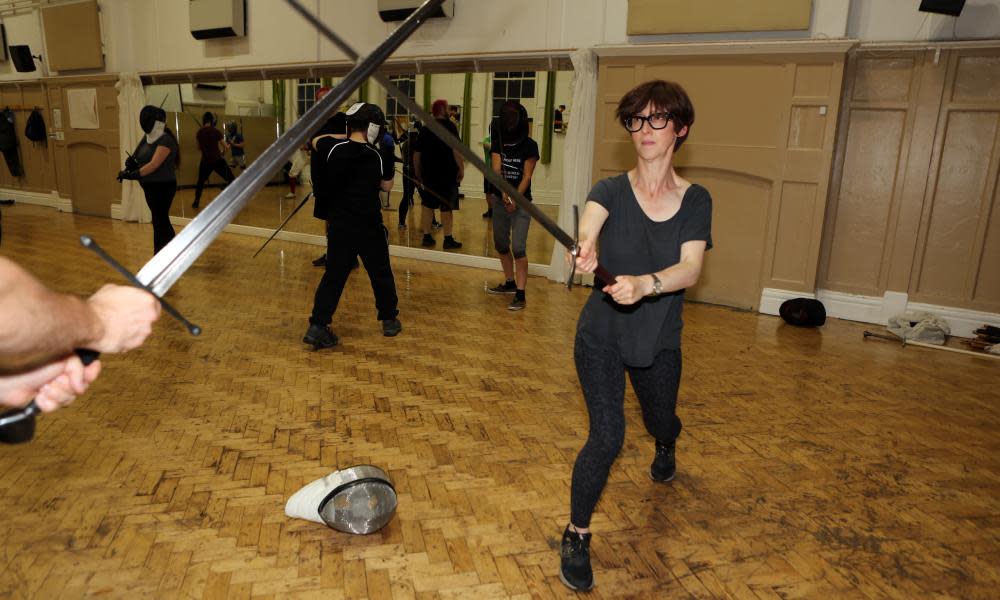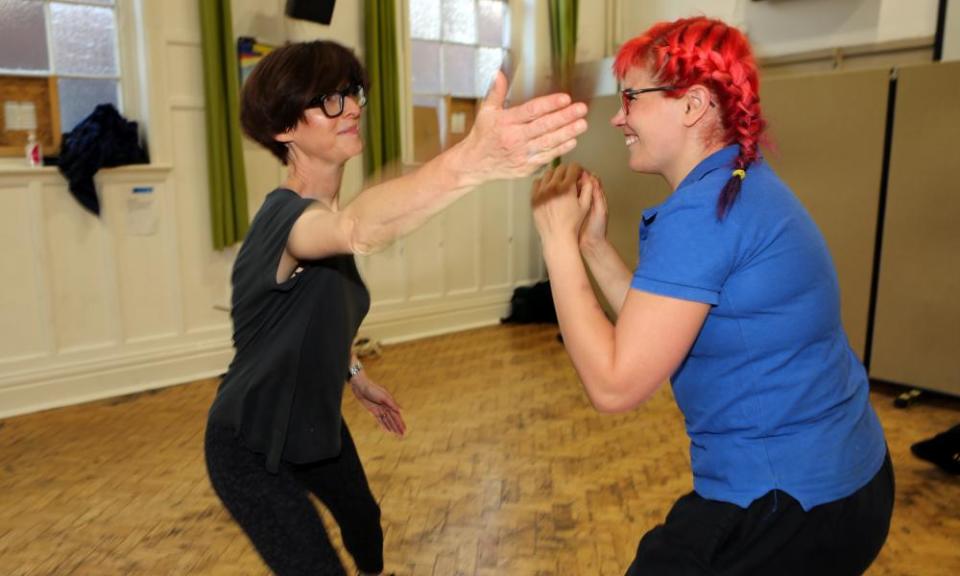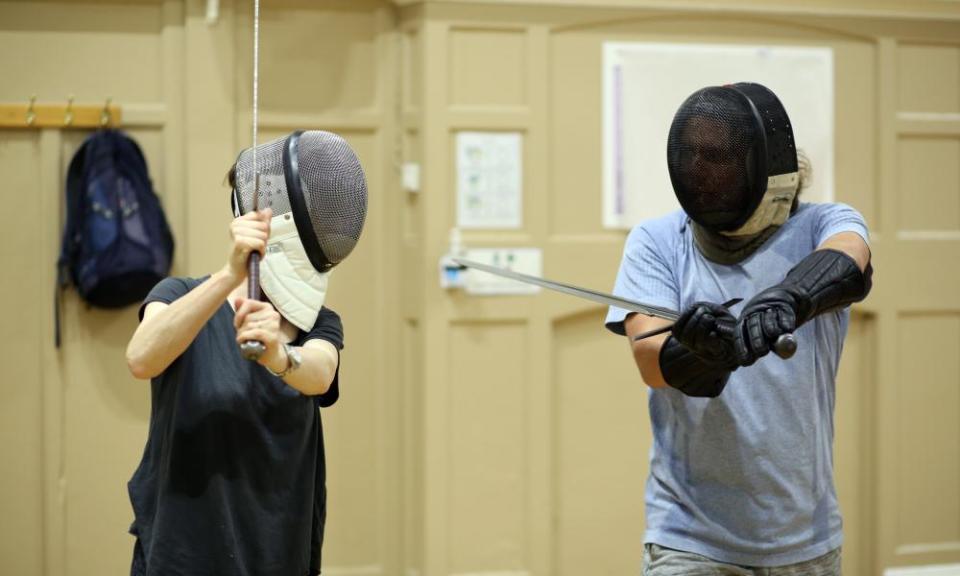Emma Beddington tries … sword-fighting: ‘I have the upper body strength of cooked spaghetti’

I recently learned there is a Bake Off equivalent for sword making: Forged in Fire, an epic struggle between (almost exclusively) men and hot metal. Each episode climaxes with the show’s Paul Hollywood figure testing blades on a jelly torso filled with fake blood. If your sword wreaks graphic gelatinous carnage, you get the equivalent of a Hollywood handshake: the accolade “Your blade will keal” (which supposedly means it will “keep everyone alive” but that homophone is not accidental). I find the jelly torso slashing deeply, troublingly satisfying, so I’m trying a sword-fighting class at York School of Defence: I want to keal.
We’re using English longswords. “It’s what you would think of as a classic knightly sword – you hold it in two hands,” says Chris Halpin, the head coach and genial pink-haired martial arts expert. Halpin has been teaching Hema (Historical European martial arts) here for nine years. It’s different from historical reenacting, which, he explains, often uses made-up combat for safety reasons. Hema teaches authentic fighting techniques from historical manuscripts: today’s class is mainly based on the 16th-century Ledall Roll.
The gathered pupils (mainly twentysomethings; perhaps unsurprisingly several are medieval historians) aren’t just holding their very long swords. They are swinging and swishing impressively; the hall dividers bear the scars of past flourishes. Most have their own blades, which I find ineffably cool and somewhat alarming. Imagine striding into Starbucks with a longsword! Actually, I don’t have to imagine it, I live in York. Seeing axe-trailing Vikings asking for Rescue Remedy in the chemist, or Roman legionaries queueing in Pret is an everyday occurrence; of course Hema is big here.
Swordfight club has pleasingly few rules. “What’s the first rule?” shouts Chris. “Don’t die!” chorus his pupils. “And what’s the second rule?” “Kill the other guy!” I am paired with Lauren, a preternaturally cheerful woman with rainbow hair in plaits. She fell in love with Hema after a trial session that involved groin stamping, she says, happily. Warm-up involves trying to kick her shins, then slap her (gently) around the head. This seems … rude? I’m uneasy and apologise if I make contact. It’s not that I don’t have anger to draw on: I’m a seething cauldron of grievances, my inner monologue sounds like a hornets’ nest and I threw my wallet at a bluebottle last week. But repression is the way of my people: naked aggression, for me, is a quiet tut, or using the phrase “as explained previously” in an email.

Unsurprisingly, my cautious kicks and slaps lack the desired martial energy: “You look like you’re riverdancing!” says Lauren. Things gets worse when I get a sword, and not just because I keep getting my enormous head stuck in the fencing helmet.
The theme of tonight’s class is the “proffer”, a strategic move designed to draw your opponent out. The starting attack is simple: sword over right shoulder, left foot forward, swing downwards, then step and stab. But my opponents must face an adversary as deadly as any blade: my complete inability to follow basic physical instructions.
I try my proffer again and again, variously forgetting to swing, step or stab. I confuse up and down, and “true” (the knuckle side of the sword) and “false” (the other). Chris identifies other issues: “You’re chasing your opponent down.” “Isn’t that a good thing?” I ask, confused. No: apparently, I’ll probably break the “don’t die” rule and I definitely won’t kill the other guy. I’m also holding the sword incorrectly. “I can see your veins bulging from across the room,” he says, which again sounds impressive, but apparently your grip should be loose, “like holding a bread knife”, to maximise the lever effect.
I eventually grasp the basic mechanics, but Chris keeps demonstrating extra moves to create a fight sequence with the kind of instructions that leave me slack-jawed in confusion. I enjoy trying the “hanging parry”, a fancy-looking bit of business that makes me feel like Dogtanian. But “rakes” – a sort of rising cut – are way too technical and lose me completely. Most of the time, the sword hangs limply over my shoulder: I have the upper-body strength of cooked spaghetti, and would have severed my own arm in the first minute if the blade were sharp.
My biggest problem, however, remains my reluctance to make contact. “You can hit me!” encourages Lauren, rapping her fencing mask. “It’s totally fine!” But I can’t find the will to kill, even if I pretend Lauren doesn’t sort her recycling. I have the same problem with my other adversaries, despite their kind encouragement. I think that’s part of the problem: they’re so nice! Why would I try to disembowel them?

We end the night with some thrilling close-contact violence, including trying to jab your opponent’s teeth out with the pommel (non-business) end of the sword. I’m paired with James, a seemingly gentle soul with blond curls, who tells me his favourite technique is something bloodthirsty called a “murder hew”. Inspired by his enthusiasm and revved up by the sound of clashing steel across the room, I finally muster a shred of bloodlust and stumble through a couple of technically inept attacks. It’s no red wedding, but it feels great. I ache for days afterwards: you don’t get that with tutting.
Would I go back?
I should: spending 90 minutes wielding a massive sword brings deep, lasting calm.
Smugness points:
1/5. My blade will never keal, but you should see my email.
Rhik Samadder is on holiday. Want to suggest an activity for Rhik or Emma to try? Tell us about it here


